Distributed Impulsive Consensus of the Multiagent System without Velocity Measurement
Abstract
This paper deals with the distributed consensus of the multiagent system. In particular, we consider the case where the velocity (second state) is unmeasurable and the communication among agents occurs at sampling instants. Based on the impulsive control theory, we propose an impulsive consensus algorithm that extends some of our previous work to account for the lack of velocity measurement. By using the stability theory of the impulsive system, some necessary and sufficient conditions are obtained to ensure the consensus of the controlled multiagent system. It is shown that the control gains, the sampled period and the eigenvalues of Laplacian matrix of communication graph play key roles in achieving consensus. Finally, a numerical simulation is provided to illustrate the effectiveness of the proposed algorithm.
1. Introduction
Recently, distributed consensus has received great interest in the control community, due to broad applications in formation [1], flocking [2, 3], synchronization in complex network [4, 5], distributed filtering [6], distributed optimization [7], and so forth. The main idea of distributed consensus is that each agent only communicates with its neighbors while the whole system of agents can converge to a common value, which by nature is a local distributed algorithm. Vicsek et al. [8] studied a simple discrete-time model of agents moving in the plane with the same speed but with different headings via simulations. The corresponding theoretical analysis was provided in [9]. Olfati-Saber and Murray presented the framework of the distributed consensus in [10], where the distributed consensus was studied in the multiagent system with fixed/switching topology and with/without delays. From then on, much progress has been made in the studies of the distributed consensus of the multiagent system in recent years [11–14]. There is a growing interest focusing on the consensus algorithms of the second-order multiagent system. Lin and Jia [15] studied the consensus problem of the multiagent system with nonuniform timedelays and dynamically changing topologies. In [16, 17], Su et al. investigated second-order consensus of the multiagent system with nonlinear dynamics and a virtual leader in a dynamic proximity network.
Due to the application of communication, the distributed consensus with sampled communication has received much attention in recent years. Many valuable algorithms have been proposed to deal with sampled communication [18–25], where distributed algorithms regulate the velocity of each agent continuously in the sampling period. On the other hand, most consensus algorithms for the multiagent system rely on the availability of the full state, only limited works [26–29] have been done when velocity information is unmeasurable.
The main contribution of this paper is to propose an impulsive consensus algorithm for the multiagent system without velocity measurements in the presence of sampled communication. The impulsive control strategy is effective when the state can be regulated instantaneously. This kind of algorithms are reasonable for many network systems. For example, in multi vrobot systems, the velocity of each robot can be changed very quickly, and the operating time of the actuator is much smaller than the sampling time. Impulsive control strategies for the multiagent system with nonlinear (linear) dynamics were considered in [30–32], where the impulsive controllers regulate all states of each agent in the system. We introduced impulsive algorithms for the multiagent system in [33–35], where only the velocity of each agent is regulated by the algorithms. In [33], some necessary and sufficient conditions are obtained for consensus/static consensus of the multiagent system. The consensus means that all the agents asymptotically tend to the zero-relative position (the agents may still change their positions) with a common velocity. The static consensus can ensure that all the agents tend to a common position. The leader-following case was studied in [35]. In [34], we proposed an impulsive consensus algorithm without velocity measurement for static consensus of multiagent system. How to achieve consensus without velocity measurement is still an open problem, which is the motivation of the study presented in this paper.
This paper is organized as follows. In Section 2, some necessary mathematical preliminaries are given, and the impulsive algorithm without using velocity information is also introduced. The main results of this paper, that is, the convergence of the proposed algorithm, are presented in Section 3. In Section 4, an illustrative numerical example is given. The concluding remarks are finally stated in Section 5.
Notation. Let ℕ and ℝ denote the natural numbers and the set of real numbers, respectively. In and 0n×m are the identity matrixes of order n (or simply I if no confusion arises) and the n × m matrix with all elements equal to zero (or simply 0 if no confusion arises), respectively. ρ(A) denotes the spectral radius of squares matrix A. For γ ∈ ℂ, Re(γ) and Im (γ) are the real part and the imaginary part of γ.
2. Preliminary and Problem Formulation
A directed path in a digraph 𝒢 is an ordered sequence v1, v2, …, vk of agents such that any ordered pair of vertices appearing consecutively in the sequence is an edge of the digraph, that is, (vi, vi+1) ∈ ℰ, for any i = 1,2, …, k − 1. A directed tree is a digraph, where there exists an agent, called the root, such that any other agent of the digraph can be reached by one and only one path starting at the root. 𝒯𝒢 = {𝒱𝒯, ℰ𝒯} is a directed spanning tree of 𝒢, if 𝒯𝒢 is a directed tree and 𝒱𝒯 = 𝒱.
Definition 1. Consensus in the multiagent system (2) is said to be achieved, if, for any initial state, lim t→∞∥pi(t) − pj(t)∥ = 0 and lim t→∞∥vi(t) − vj(t)∥ = 0, where i, j ∈ 𝒱.
In this paper, we assume that both the absolute and relative velocities are unmeasurable, and the communication among agents occurs at sampling instants. The sampled sequence is given by , which satisfies 0 < t1 < t2 < ⋯ < tk < ⋯, lim k→∞tk = ∞, and tk+1 − tk = h, where sampling period h is positive constant. The following impulsive algorithm without using any velocity information is proposed and described by the following impulsive differential equations:
Remark 2. The proposed algorithm only uses sampled information of relative position (i.e. xi(t) − xj(t)) which is different from [26–29], where the continuous position information is required. It is also different from our previous work [34] which requires the sampled information of relative position to itself in previous sampling instant (i.e., xi(tk) − xi(tk−1)).
The following lemmas are needed in the proof of the theorem.
Lemma 3 (see [36].)Zero is a simple eigenvalue of ℒ, and all the other eigenvalues have positive real parts if and only if 𝒢 contains a spanning tree.
From [4, 37], we can get the following lemma.
Lemma 4. Let ℒ be the Laplacian matrix of the graph 𝒢. Then the (N − 1)×(N − 1) matrix defined by satisfies . Furthermore,
Lemma 5 (see [29].)The complex polynomial R(z) = z2 + az + b, where α ∈ ℂ and β ∈ ℂ, is Hurwitz stable if and only if Re(a) > 0 and Re(a)Im (a)Im (b) + Re2(a)Re(b) − Im 2(b) > 0.
3. Consensus in Multi-Agent System
Denote the eigenvalues of L, respectively, by λ1, λ2, …, λr, where λ1 = 0. According to Lemma 3, λ1 = 0 is a simple eigenvalue if 𝒢 contains a spanning tree. Note that when 𝒢 is a directed graph, λi, for i = 1,2, …, r, may be complex numbers.
Theorem 6. The controlled multiagent system (3) can achieve consensus if and only if the graph G contains a spanning tree and ρ(Ml) < 1, where λl are the nonzero eigenvalues of ℒ, l = 2, …, r,
Proof. Note that pi(t) is continuous at t = tk. From (3), one has
Then, one has
Let and ; then,
Note that
is an invertible matrix. According to Lemma 3, λ1 = 0 is a simple eigenvalue of ℒ if the 𝒢 contains a spanning tree (it is well known that 𝒢 contains a spanning tree which is a necessary condition for consensus). Then, do not have zero eigenvalue. This implies that the eigenvalues of are λ2, λ3, …, λr. Then, there exists a nonsingular matrix P ∈ ℝ(n−1)×(n−1), such that
Nl is multiplicity of eigenvalue λl and N2 + ⋯+Nr = N − 1.
Let , where . Then, from (12),
Theorem 7. The controlled multiagent system (3) achieves consensus asymptotically if and only if the communication graph 𝒢 contains a spanning tree and
Proof. Let μ be an eigenvalue of matrix Ml. Then,
Let
If β1 − λiαβ2 = 0, 1 is a root of Pl(μ) = 1. Therefore, λih(β1 − λiαβ2) ≠ 0, if the consensus can be achieved. Then, the consensus can be achieved if and only if the polynomials , for l = 2, …, r, are Hurwitz stable, where
It is easy to check
Remark 8. According to the previous discussion, both the real and imaginary parts of the eigenvalues of the Laplacian matrix play key roles in achieving consensus. The necessary and sufficient conditions in Theorems 6 and 7 are too complicated to directly display the relationship among consensus, control gains, and sampled period.
When it comes to undirected graph, the results will be more simple.
Corollary 9. The controlled multiagent system (3) achieves consensus asymptotically if and only if the undirected communication graph 𝒢 is connected and
Proof. It is well known that ℒ contains N − 1 positive real eigenvalues if 𝒢 is a connected undirected graph. Then, one has b = 0 and d = 0. From Theorem 7, (18) and (19) hold if and only if (26) is satisfied. The proof is thus completed.
Remark 10. Equation (26) is nonempty, when
So, we can choose the control gains α and β2 from (28) and choose β1 from (26). Therefore, it is quite easy to find suitable control gains for any connected graph 𝒢 and sampled period h.
The following corollary will show, when the control gains are given, how to determine suitable control gains h.
Corollary 11. The controlled multiagent system (3) can achieve consensus if and only if the undirected communication graph G is connected,
Remark 12. When β1 > λiαβ2 is not satisfied, the consensus will fail. The upper bound of sampled period increases as λmax , α, β1, and β2 decrease. The sampled period h does not have the lower bound, which is different from [34].
4. Illustrative Examples
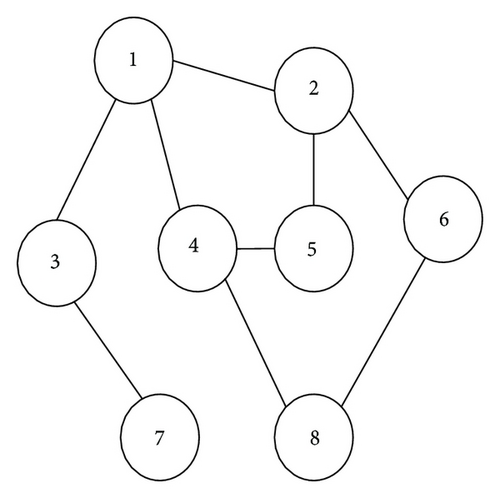
By calculation, one has λ1 = 0, λ2 = 0.4965, λ3 = 1.7356, λ4 = λ5 = 2, λ6 = 3.5767, λ7 = 4, and λ8 = 5.1912.
From Corollary 9, the consensus can be achieved if and only if 0.2596 < β1 < 0.5110. Figures 2 and 3 show that consensus cannot be reached when β1 = 0.2 and β1 = 0.55 but can be achieved when β1 = 0.3 (shown in Figure 4).
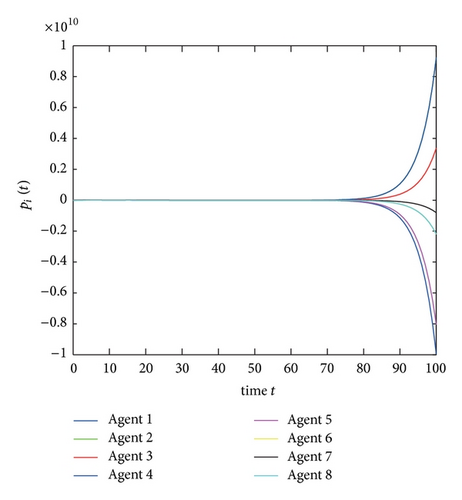
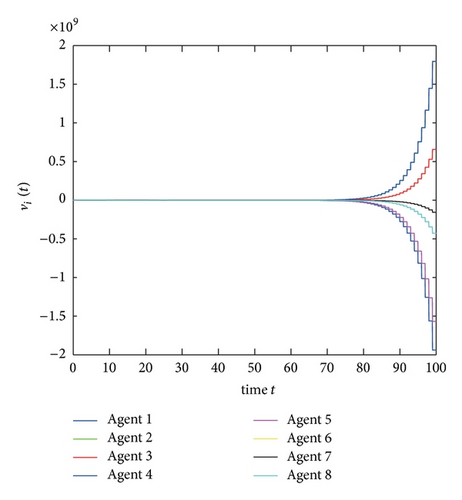
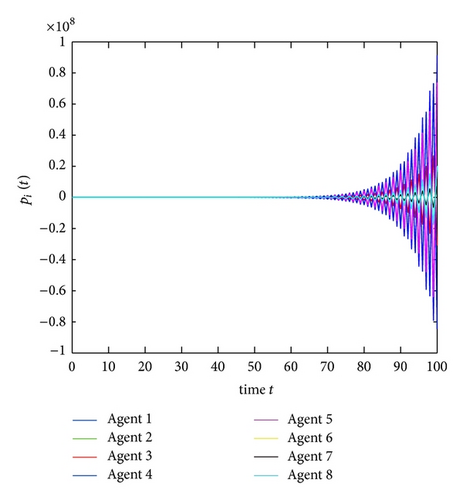
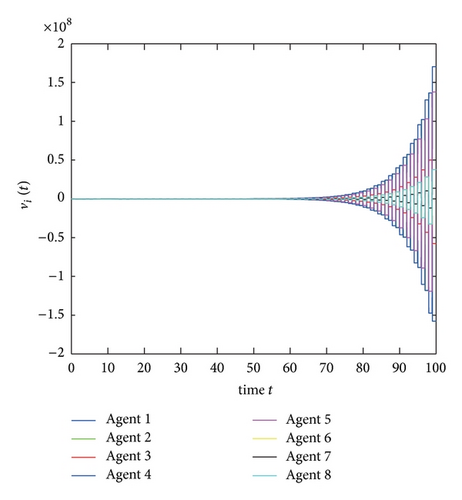
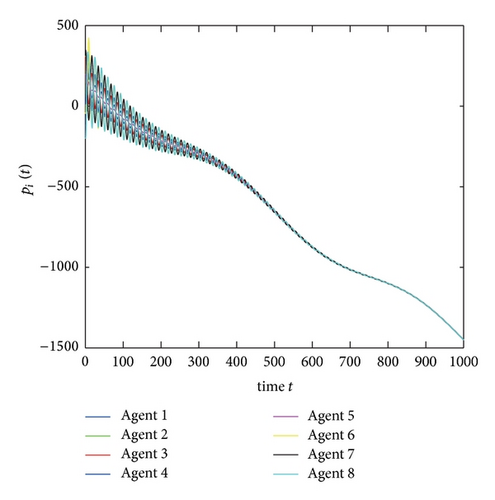
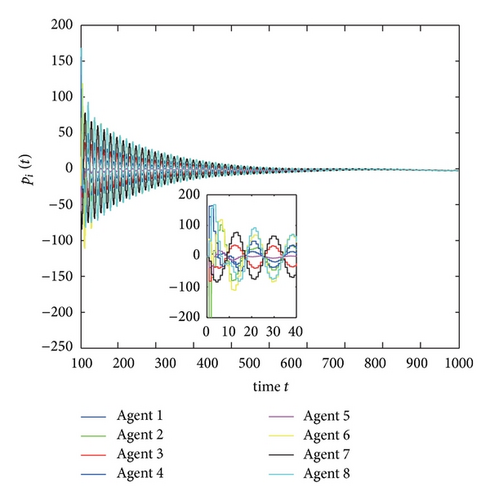
5. Conclusions
In this paper, the distributed consensus problem has been considered for the continuous-time multiagent system under intermittent communication. Motivated by impulsive control strategy, an impulsive consensus algorithm has been proposed, where the local algorithm of each agent is only based on the position information. Based on the stability theory of impulsive systems and the property of graph Laplacian matrix, some necessary and sufficient conditions for consensus have been obtained. From the results, we can easily find out suitable control gains for consensus. Finally, a numerical example is given to verify the theoretical analysis. It would be interesting to further investigate the multiagent system with switching topology via impulsive control to realize consensus.
Acknowledgments
This work was supported in part by the China Postdoctoral Science Foundation funded project 2012M511258 and the National Natural Science Foundation of China under Grants 61073026, 61170031, 61272069, and 61004030.




